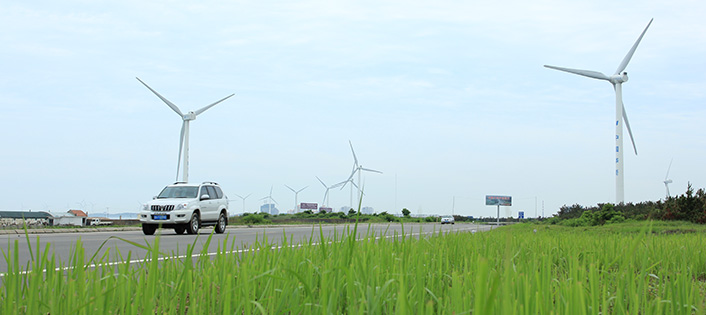
What is wind power?
Wind power is the air's kinetic energy or the energy that wind produces. The strength of wind power depends on wind speed and air density.
Where does wind power originate from?
Wind energy is derived from the sun's radiant energy. The sun radiates 174,423,000,000,000 kilowatts of energy to the Earth every hour, which translates into 1.74 x 1017 watts of energy. Wind power makes up about 10% to 20% of the sun's total energy. Part of the sun's radiant energy is converted into biotic energy by plants, while 50 to 100 times that amount of energy is converted into wind power.
What is the total wind power in our country?
The total wind power reserves at the 10m level are 3.226 billion kilowatts, of which 253 million kilowatts of wind power reserves can actually be exploited and used. China's offshore wind power is estimated to be three times inland wind power, leading to a total of 1 billion kilowatts of exploitable wind power. China's regions where wind power reserves are concentrated in are Qinghai, Gansu, Xinjiang and Inner Mongolia with exploitable wind power reserves of 11.43, 24.21, 34.33 and 61.78 million kilowatts respectively.
Why is wind power classified as a renewable energy source?
Wind power is a clean and natural energy source, and does not pollute the environment like conventional energy sources (such as coal and petroleum) and power from nuclear (fission). Every 1.5MW wind turbine installed is able to reduce an average of 3,000 tons of carbon dioxide (equivalent to planting 1.5 square mile of trees), 15 tons of sulfur dioxide and 9 tons of nitrogen dioxide. For every 1,000kWh of electricity generated, wind power can reduce 0.8 to 0.9 tons of greenhouse gases, which is equivalent to the gases released by burning coal or fossil fuels in a year. In addition, wind turbines will not cause any harm to other wildlife except some birds. Under the pressure of the critical depletion of conventional energy sources and the deterioration of the world's ecological environment, wind power has tremendous potential for development as a new energy source that is highly-effective and clean.
Wind power in human history
The use of wind power by mankind can be traced back to the era before the birth of Christ. As one of the pioneers of wind power exploitation, our ancestors had begun using wind power since several centuries B.C. ago to draw water, irrigate, grind flour, husk rice and propel a ship using sails. The sailboats on Egypt's Nile River and China's wooden sailboats have existed for 2,000 years ago. A poem in the Tang Dynasty's reciting that "a time will come for me to sail in the midst of winds and waves across the vast ocean towards my destiny" reflects that sailboats had been a common means of transportation for crossing rivers. During the Song Dynasty, the use of windmills began to flourish and the then-booming vertical shaft windmill has sustained till today. The use of wind power overseas can be dated back two centuries B.C. when ancient Persians used vertical shaft windmills to polish rice. In the 10th century, Muslims used windmills to draw water, which led to the widespread use of windmills in the Middle East by the 11th century. In the 13th century, the windmill was brought to Europe, and quickly became an indispensable prime mover in the 14th century. In Holland, windmills were first used to drain the Rhine River delta and low-lying lands. The windmills could attain 50 horsepower, and were subsequently used for oil extraction and sawmills. In the 1720s, windmills were used to irrigate agricultural fields and to drive generators to produce electricity. From 1887 to the end of 1888, Charles F. Brush, one of the founders of America's electrical power industry, installed an automated electricity-generating wind turbine in Ohio, which is widely considered as the first of its kind. From 1920, scientists began to research into the use of windmills to generate large-scale electricity. In 1931, a 100kW wind turbine was constructed in Crimean Balaclava, Soviet Union, beginning the commercialization of wind turbines.
What are the advantages of developing wind turbines to generate electricity?
With the rapid advancement in wind technology, reliable product quality and more than 95% feasibility rates, wind power has become a safe and reliable energy source. With ever-increasing economization of generating electricity using wind power, the costs are becoming comparable to that for coal-fired generators and are lower than petroleum-fired and nuclear generators. Taking into account the intermediary investments in environmental protection and transportation, it is more economical to use wind power in place of coal to generate electricity. In addition, the construction of wind power stations takes a relatively shorter amount of time. The installation and adjustment of a wind turbine system takes a few weeks, and the whole process of land construction, installation and commencement of productions will only take 6 months to one year – a feat which coal-fired or nuclear stations cannot match up to. The investment scope is also flexible; one can chose to install as much capacity as possible based on the available capital. For offshore islands, remote highlands which are inaccessible, vast but thinly-populated grasslands and pastures, and rural villages and frontier regions which are far away from power supply networks and will continue to remain unreached, wind power can be an effective energy source for production and survival, which further enhances its significance.

